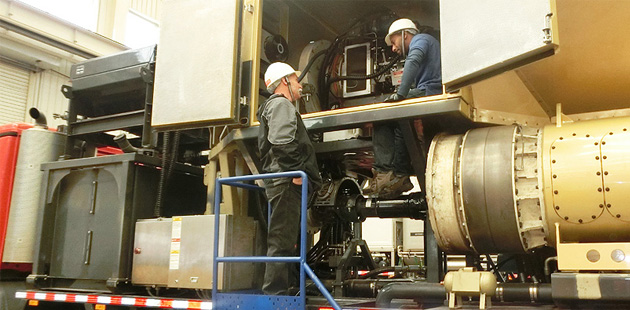Thorough Testing is the Key to Customer Satisfaction
in Gas Turbine Frac Equipment
With the push to incorporate gas turbine usage into hydraulic fracturing applications, a testing program evaluating the effectiveness of the gas turbine frac package was needed. While many fracturing conditions can be simulated in the controlled environment of a dedicated test facility, field testing provides the best opportunity to confirm the capability of the frac system to perform as desired by the end customer. Development testing in the field provides a measure of identifying previously unknown issues during the development phase, allowing for modifications to prevent these issues from occurring in the early phases of production.
Factors to Consider During Field Testing
A number of factors must be taken in consideration in preparation for the testing at the frac site. The type of fracing operation (horizontal or vertical, initial frac, multi-stage frac, well-stimulation, etc.) dictates the operation time and the amount of pressure and flow required from the frac pump to complete the process. At the beginning of the frac operation, targets for the wellhead pressure, proppant flowrate and proppant composition are determined. With gas turbine frac pumps having the capacity to allow more flow and generate higher pressures than diesel driven systems, the test objectives for these packages are higher than diesel driven frac systems at site.
Performance and operability are key factors that were monitored with the gas turbine during the fracing operation. Factory testing of a single frac pump package limits the ability to effectively demonstrate starting of the package under increased pressure from the wellhead. As the fracing process begins, each of the frac systems start in sequence and accelerate to idle, causing a buildup in back pressure from the well. By the time the last of the frac systems has started a significant level of pressure may be placed on the pump, requiring the gas turbine to generate enough torque during the start to overcome this inertia. Smooth transient response of the system is another key operability factor, which is important as the load and flowrate demanded by the frac pump change. As the system reaches a steady-state condition, stability of the engine and frac package is important to reduce any fluctuations caused during the process. The performance of the system is monitored throughout, as the ambient conditions change the horsepower and fuel consumption of the gas turbine engine.
Another key area evaluated during the field testing was the integration of the frac package. During the initial testing phase special attention was paid to ensure that the hydraulic fracturing package sub-systems perform as designed. The hydraulic and electrical systems must perform and respond to ensure that accessory components function as intended. Communication between the engine and package controls is critical to ensure that the frac package components function as commanded and that safeguards are in place to protect the system. Details of the fuel delivery system (either liquid, natural gas, or both) were noted to ensure that the fuel quality and delivery pressures were provided as demanded.
During the field testing, additional measures were needed to ensure that an appropriate plan for monitoring the testing and collecting beneficial data was established. A data van is located at the frac site in a safe location to reduce the risk of harm to any personnel while the frac operation takes place. Each of the frac pumps, along with all other supporting equipment can be monitored remotely from this location. The gas turbine frac package allows for incorporating additional instrumentation during these tests, such that pressures and temperatures are verified and the gas turbine frac system and components function properly. It is imperative that this data is collected to further understand the characteristics of the gas turbine frac system, to troubleshoot any issues that arise during testing, and to acquire lessons learned that are used to further optimize the operation of the gas turbine frac package.
Conclusion:
Gas turbine powered frac packages are proving to be the preferred alternative to traditional diesel powered frac package based on performance, reliability, availability, and operating cost of the system, particularly when operating on well head gas. As experience through field testing grows, so will the customers' confidence in using gas turbines to drive their hydraulic fracturing equipment in the near future.

